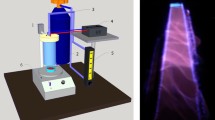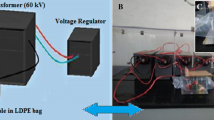Abstract
Pasteurization is an important issue to keep from fruit decay due to microbes for fruit preservation. Conventional heat sterilization is based on thermal process. However, the flavor and nutrition components can be changed by heat damage. In this study, an apparatus was designed to produce non-thermal plasma (NTP), which can be applied in fruit sterilization. NTP can be generated through electric discharge in gaseous chamber. A simple NTP reactor may consist of two electrodes with a chamber and connected to a high-voltage power supply. The new technique of NTP was applied to keep fruit fresh. After the tomatoes were treated by NTP, the volatile flavor components were analyzed by GC–MS and were compared to heat treatment and non-treatment. The results showed that the quality of fresh tomato fruit was unaffected by plasma disinfection treatment, and the contents of trans-2-hexenal and n-hexanal were significantly higher than that by heat processes. NTP has less effect on volatile chemical compositions of tomato juice. NTP technology is a promising method for food pasteurization in the future.




Similar content being viewed by others
References
Augusto PED, Ibarz A, Cristianini M (2013) Effect of high pressure homogenization (HPH) on the rheological properties of tomato juice: viscoelastic properties and the Cox–Merz rule. J Food Eng 114:57–63
Baier M, Foerster J, Schnabel U (2013) Direct non-thermal plasma treatment for the sanitation of fresh corn salad leaves: evaluation of physical and physiological effects and antimicrobial efficacy. Postharvest Biol Technol 84:81–87
Bayliss DL, Shama G, Kong MG (2013) Restoration of antibiotic sensitivity in meticillin-resistant Staphylococcus aureus following treatment with a non-thermal atmospheric gas plasma. Int J Antimicrob Agents 41:398–399
Boulekou S, Mallidis C, Taoukis PS, Stoforos NG (2011) Quality evaluation of slightly concentrated tomato juice produced under high pressure conditions. 11th international congress on engineering and food (ICEF11). Procedia Food Sci 1:800–804
Butz P, Fernandez Garcia A, Lindauer R, Dieterich S, Bognar A, Tauscher B (2003) Influence of ultra-high pressure processing on fruit and vegetable products. J Food Eng 56:233–236
De la Noue AC, Espinasse V, Perrier-Cornet JM, Gervais P (2012) High gas pressure: an innovative method for the inactivation of dried bacterial spores. Biotechnol Bioeng 109:1996–2004
Deng SR, Ruan CY, Mok G (2007) Inactivation of Escherichia coli on almonds using nonthermal plasma. J Food Sci 72:62–66
Ermolaeva SA, Sysolyatina EV, Kolkova NI, Bortsov P, Tuhvatulin AI, Vasiliev MM, Mukhachev AY, Petrov OF, Tetsuji S, Naroditsky BS, Morfill GE, Fortov VE, Grigoriev AI, Zigangirova NA, Gintsburg AL (2012) Non-thermal argon plasma is bactericidal for the intracellular bacterial pathogen Chlamydia trachomatis. J Med Microbiol 61:793–799
Gurol C, Ekinci FY, Aslan N, Korachi M (2012) Low temperature plasma for decontamination of E. coli in milk. Int J Food Microbiol 157:1–5
Hayase F, Chung TY, Kato H (1984) Changes of volatile components of tomato fruits during ripening. Food Chem 14:113–124
Lin XY, Ruan RS, Zhu RB (2006) Study on a new non-thermal pasteurization technique for liquid foods. Food Sci 27:57–61
Liu XH, Hong F, Guo Y, Zhang J, Shi JJ (2013) Sterilization of Staphylococcus Aureus by an atmospheric non-thermal plasma jet. Plasma Sci Technol 15:439–442
Ma HB, Ruan R, Lin XY (2002) Non-thermal pasteurization of liquid foods using non-thermal plasma. Trans CSAE 18:155–159
Ma RN, Feng HQ, Liang YD (2013) An atmospheric-pressure cold plasma leads to apoptosis in Saccharomyces cerevisiae by accumulating intracellular reactive oxygen species and calcium. J Phys D Appl Phys 46:85401–85429
Moreau M, Orange N, Feuilloley MGJ (2008) Non-thermal plasma technologies: new tools for bio-decontamination. Biotechnol Adv 26:610–617
Perni S, Liu DW, Shama G (2008) Cold atmospheric plasma decontamination of the pericarps of fruit. J Food Prot 71:302–308
Riu-Aumatella M, Castellar M, Lopez-Tamames E, Galassi S, Buxaderas S (2004) Characterization of volatile compounds of fruit juices and nectars by HS/SPME and GC/MS. Food Chem 87:627–637
Salles S, Nicklaus, Septier C (2003) Determination and gustatory properties of taste-active compounds in tomato juice. Food Chem 81:395–402
Sebastiano P, Alessandra B, Claudio G, Enzo V (1995) Effects of ultra-high hydrostatic pressure treatments on the quality of tomato juice. Food Chem 52:35–41
Servili M, Selvaggini R, Taticchi A, Begliomini AL, Montedoro GF (2000) Relationships between the volatile compounds evaluated by solid phase microextraction and the thermal treatment of tomato juice: optimization of the blanching parameters. Food Chem 71:407–415
Surowsky B, Fischer A, Schlueter O, Knorr D (2013) Cold plasma effects on enzyme activity in a model food system. Innov Food Sci Emerg Technol 19:146–152
Tian HX, Yi YJ, Zheng XP (2009) Analysis of volatile flavor compounds in homemade cheese with the use of simultaneous distillation extraction and gas chromatography-mass spectrometry. Food Ferment Ind 53(11):143–146
Acknowledgments
This work was supported by Shenzhen Science and Technology Project (Fund No. JC200903180677A),and General Administration of Quality Supervision, Inspection and Quarantine (AQSIQ) Science Project (Fund No. 2013IK052), China.
Author information
Authors and Affiliations
Corresponding author
Rights and permissions
About this article
Cite this article
Ma, T.J., Lan, W.S. Effects of non-thermal plasma sterilization on volatile components of tomato juice. Int. J. Environ. Sci. Technol. 12, 3767–3772 (2015). https://doi.org/10.1007/s13762-015-0796-z
Received:
Revised:
Accepted:
Published:
Issue Date:
DOI: https://doi.org/10.1007/s13762-015-0796-z




